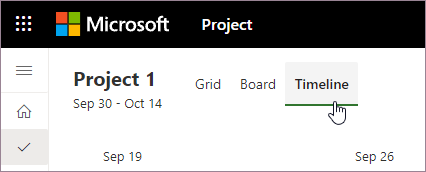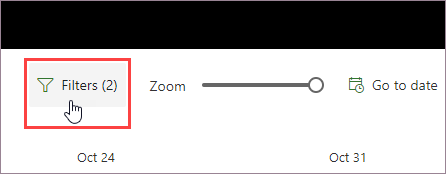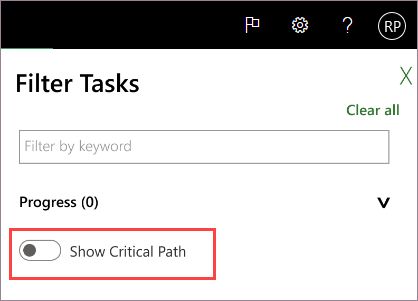How To Create A Critical Path
Show the critical path in the Gantt Chart view
The Gantt Chart view will likely be your most used view for showing the critical path.
-
Choose View > Gantt Chart.
-
Choose Format, and then select the Critical Tasks check box.

Tasks on the critical path now have red Gantt bars.
Show the critical path in other task views
You can see the critical path in any task view by highlighting it.
-
On the View tab, pick a view from the Task Views group.
-
Staying on the View tab, select Critical from the Highlight list.
The critical path shows up in yellow. -
To see only the tasks on the critical path, choose the Filter arrow, then pick Critical.

Tip:In a Network Diagram, tasks on the critical path automatically show up in red. No highlighting is needed.
Video: Show the critical path
This video demonstrates how to display the critical path in your project, in both the Gantt Chart view and other views.

View the critical path in a master project
When you're managing a master project, whole subprojects can be on the critical path. You can see if this is true by telling Project to treat the subprojects like they are summary tasks.
-
Choose File > Options.
-
Choose Schedule, and then scroll down to the Calculation options for this project area.
-
Make sure the Inserted projects are calculated like summary tasks box is selected.
Tip:This setting does not affect other projects. That is, it only applies to the master project you're working on.
Change what tasks show up on the critical path
Typically, critical tasks have no slack. But you can tell Project to include tasks with one or more days of slack on the critical path so you can see potential problems coming from farther away.
-
Choose File > Options.
-
Choose Advanced, and then scroll down to the Calculation options for this project area.
-
Add a number to the Tasks are critical if slack is less than or equal to box.
Top of Page
Show multiple critical paths
You can set up your project schedule to display as many critical paths as you need to keep tabs on your project.
-
Choose File > Options.
-
Choose Advanced, scroll down to the bottom, and then select Calculate multiple critical paths.
-
Choose View > Gantt Chart.
-
Choose Format, and then select Critical tasks.
By default, Project shows only one critical path, the one that affects the project's finish date. But you might need to see more than one for a couple reasons:
-
To make sure each subproject of a master project is on time.
-
To track the progress of different phases or milestones.
-
To keep an eye on any series of tasks for any reason.
Project management tip: When viewing multiple critical paths, don't forget that there's still only one main critical path. If it falls behind schedule, the whole project falls behind schedule. Try these tips to make better use of multiple critical paths in a project once you've set them up.
| Try this | Here's how |
|---|---|
| Work with multiple projects in one schedule |
|
| Show only critical tasks | On the Gantt Chart, choose View > Filter > Critical. To display all tasks again, select No filter in the filter list. |
| Group critical tasks | On the Gantt Chart, choose View > Group By > Critical. To display all tasks again, select No Group in the group list. |
More about critical path analysis
If you have saved a baseline for your project, the critical path can show you if your project will finish on time and where the danger points are. To get the most out of critical path analysis:
-
Regularly view the critical path. Be aware that the critical path can change from one series of tasks to another as you progress through the schedule. The critical path can change as critical tasks are completed or as other series of tasks are delayed.
-
Closely monitor critical tasks. Any task on the critical path is a critical task. Monitor these tasks regularly to see if any of them slip. If a critical task slips, so does your finish date. Save a baseline and use the Tracking Gantt view to see slipped tasks.
-
Review series of tasks that may become the critical path. If a non-critical series of linked tasks slips its dates enough, that series of tasks will become the critical path. You can view other potentially risky tasks by showing multiple critical paths in a project.
-
Protect yourself by viewing tasks that can slip without affecting the critical path. By default, the critical path shows the tasks that cannot slip at all or the project date will slip. You may want to view tasks that currently can slip by a day without affecting the critical path, because if they slip by more than a day, they will become critical tasks. Viewing these tasks with slack helps alert you to tasks that are becoming critical while you still have some buffer.
Tip:To change the sensitivity of critical tasks, choose File > Options > Advanced. In the Tasks are critical if slack is less than or equal to list, enter the number of days under which a task will be considered critical.
When you display the project's critical path, Project shows only a single, overall critical path, which is the only critical path that controls the project's finish date. However, you can set up your plan so that you can also see an additional critical path for each independent network or each series of tasks. You might find this useful for keeping track of each of the subprojects within a master project, or of each phase or milestone of a project that is divided into multiple phases.
By knowing and tracking the critical path for your project, as well as the resources that are assigned to each critical task, you can identify the tasks that can affect your project's finish date and thus discover whether your project will finish on schedule.
Learn more by reading Manage your project's critical path.
Top of Page
These instructions are specific to Project 2007.
Display the critical path for your project
To verify that adjustments that you make to the project plan don't adversely affect the critical path, you can review the critical path and critical tasks in any of several ways.
Note:By default, Project 2007 does not display a project's critical path.
| To do this | Follow these steps |
|---|---|
| Show the critical path in the context of all tasks | On the View menu, choose More Views > Detail Gantt, and then choose Apply. |
| Show only critical tasks | On the View menu, choose Gantt Chart, and then select Critical in the Filter list To display all tasks again, select All Tasks in the Filter list on the toolbar. You can also group all critical tasks together. On the Project menu, point to Group by, and then select Critical. |
| Show the critical path by using the Gantt Chart Wizard | On the View menu, choose Gantt Chart, and then choose Gantt Chart Wizard By default, the Gantt chart bars and link lines for critical tasks are displayed in red. This format change overrides any direct formatting changes previously made to bar styles or to individual bars. Note that this formatting of critical tasks applies only to the current Gantt Chart view in the current file. To use the same formatting in another file, you can use the Organizer (Tools menu) to copy formatted Gantt Charts to other files. |
| Show multiple critical paths in a single project | On the Tools menu, choose Options, select the Calculation tab, and then select the Calculate multiple critical paths check box. |
| Show the overall critical path across multiple projects | Important:This procedure is only effective in a consolidated project. If you don't have a consolidated project, you must first create one. On the Tools menu, choose Options, select the Calculation tab, and then select the Inserted projects are calculated like summary tasks check box. This is a project-level setting. All projects inserted into this project will be calculated like summary tasks. |
Change which tasks are defined as critical
In Project 2007, a critical task has zero days of slack (float). However, you can change this default value and define a task as critical that has, for example, one or two days of slack.
-
On the Tools menu, choose Options, and then select the Calculation tab.
-
In the Tasks are critical if slack is less than or equal to box, enter the maximum amount of slack, in days, that you want to use to define critical tasks.
-
If you want this value to be the default value for all of your projects, choose Set as Default.
To learn how to find a task's slack, see Show slack in your project.
For instructions about changing a task's slack, see Set lead or lag time (float) between tasks.
Top of Page
More about critical path analysis
If you have saved a baseline for your project, the critical path can show you if your project will finish on time and where the danger points are. To get the most out of critical path analysis:
-
Regularly view the critical path. Be aware that the critical path can change from one series of tasks to another as you progress through the schedule. The critical path can change as critical tasks are completed or as other series of tasks are delayed.
-
Closely monitor critical tasks. Any task on the critical path is a critical task. Monitor these tasks regularly to see if any of them slip. If a critical task slips, so does your finish date. Save a baseline and use the Tracking Gantt view to see slipped tasks.
-
Review series of tasks that may become the critical path. If a non-critical series of linked tasks slips its dates enough, that series of tasks will become the critical path. You can view other potentially risky tasks by showing multiple critical paths in a project.
-
Protect yourself by viewing tasks that can slip without affecting the critical path. By default, the critical path shows the tasks that cannot slip at all or the project date will slip. You may want to view tasks that currently can slip by a day without affecting the critical path, because if they slip by more than a day, they will become critical tasks. Viewing these tasks with slack helps alert you to tasks that are becoming critical while you still have some buffer.
Tip:To change the sensitivity of critical tasks, on the Tools menu, choose Options. On the Calculation tab, under Tasks are critical if slack is less than or equal to, specify the number of days under which a task will be considered critical.
When you display the project's critical path, Project 2007 shows only a single, overall critical path, which is the only critical path that controls the project's finish date. However, you can set up your plan so that you can also see an additional critical path for each independent network or each series of tasks. You might find this useful for keeping track of each of the subprojects within a master project, or of each phase or milestone of a project that is divided into multiple phases.
By knowing and tracking the critical path for your project, as well as the resources that are assigned to each critical task, you can identify the tasks that can affect your project's finish date and thus discover whether your project will finish on schedule.
Learn more by reading Manage your project's critical path.
Top of Page
In Project for the web, you can view the critical path by using a filter.
-
In your project, select Timeline.

-
Select Filters.

-
Turn on the toggle Show Critical Path.

When Show Critical Path is on, you'll see the critical path for your project highlighted red in the timeline.

How To Create A Critical Path
Source: https://support.microsoft.com/en-us/office/show-the-critical-path-of-your-project-in-project-ad6e3b08-7748-4231-afc4-a2046207fd86
Posted by: mclaughlinfragend.blogspot.com

 on the toolbar.
on the toolbar. on the Formatting toolbar. Follow the instructions in the Gantt Chart Wizard to format the critical path.
on the Formatting toolbar. Follow the instructions in the Gantt Chart Wizard to format the critical path.
0 Response to "How To Create A Critical Path"
Post a Comment